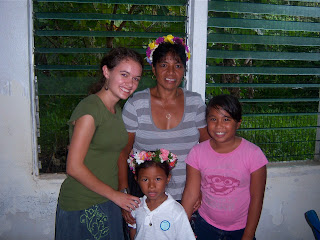Halloween isn’t celebrated here, but I was determined to make Halloween day an awesome cross-cultural learning experience for my students and host family. I was so pumped… and then came my second major Peace Corps sickness! So instead of making paper jack-o-lanterns, I ended up bedridden for most of Halloween week. I had already given my host nieces and nephews an overview of “trick-or-treating,” and they were aware that I had bought candy in Kolonia for the occasion. So on Halloween evening, I woke up from a rather delirious sleep to a knocking on my door and lots of giggles. I somehow managed to drag myself to the door, and was greeted with like a dozen extended family members screaming “Trick or treat!!” They got in trouble for waking me up, but I was so happy that I told them they had to do it again so I’d have time to get the candy ready (not sure how I managed to do all this in my physical state – Halloween mania took over!). As I opened the door the second time, I snapped this photo of them in action:

I gave them the candy, then collapsed back into bed. A few days later, when I was feeling up to it, we made masks out of construction paper. These were supposed to be cute, but they ended up kind of making the kids look like a gang of executioners or something… Oh well, all with the Halloween theme, right?
When I got back to school the following week, we had our belated Halloween-themed day. We read and wrote scary stories in 7th and 8th grade (the 8th graders wrote some very scary stories, by the way) and in 6th grade we did a reader’s theater version of “The Little Old Lady Who Wasn’t Afraid of Anything,” complete with all the sound effects and motions. It was fun!
And of course, there was the big election. I was lucky enough to receive text message updates in real time from family and friends, so I wasn’t totally out of the loop (despite being in the middle of nowhere, literally). It didn’t quite feel like an election, though, without Wolf Blitzer surrounded by ridiculous computer graphics, lol. It was WONDERFUL to be outside of the states during all the campaigns (I never saw ONE political ad – yay!!!), but it was – surprisingly – kind of a bummer to miss out on the excitement of watching the election results.
Along with these American holidays/events, it’s been a month full of Pohnpeian holidays – Independence Day, Constitution Day, Veteran’s Day, etc. This means that we haven’t had a full 5-day week of school in the past four weeks. It’s crazy. Perhaps the most ironic school holiday is “Education Day.” I wonder who had the idea for that one… “Guys, I think we should have a holiday to celebrate education… and cancel school!” Instead, all the teachers went to a party and had a talent show/dance contest. Yay, education!
At home I’m slowly forcing my way into helping out with chores. After being told I was a “princess” and therefore didn’t need to work, I gave them a long speech (well, actually rather short considering my limited Pohnpeian language abilities) about how I want to help! So along with the chores I already knew how to do (washing dishes, raking), I’ve finally mastered doing laundry by hand (hit it with a paddle!), grating coconuts (koikoi mangas – this one I actually learned how to do during training, but I finally managed to convince my family to let me do it a few weeks ago), and planting banana trees!
But there’s still plenty of down time, as evidenced by the infinite number of times I play Uno daily. One day we got bored of playing real games, so I taught the kids how to make card houses (so if I accomplish nothing else during these two years, I have already imparted knowledge to Pohnpeian children!). After we succeeded at building a house with the whole deck, things got creative as they found other ways to build card houses. I was pretty darn impressed.
If you want a better idea of island life, check out the book “The Sex Lives of Cannibals: Adrift in the Equatorial Pacific” by J. Maarten Troost (don’t be misled by the title – there are no cannibals and very little sex in this book). It’s basically a humorous collection of Troost’s experiences in the Republic of Tarawa. Different country and culture, of course, but there are tons of similarities with my experience. Plus, it’s just a hilarious read.
Or, if you’re a fan of the “What They Should Call Me” tumblr, check out this link that one of the Kosrae volunteers stumbled upon:
In closing, a photo of Oly Girl, because everyone loves puppies!




















































